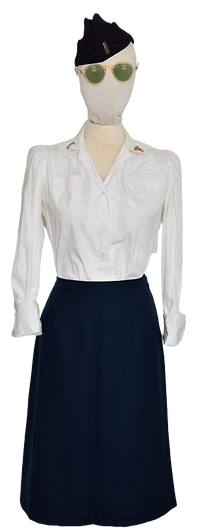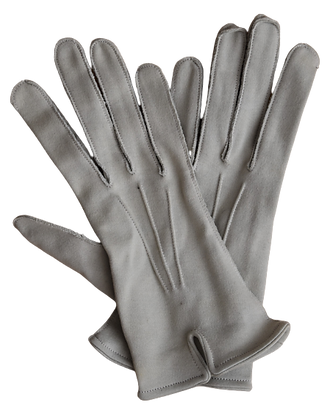
Blue Outdoor Uniform
(1941 - 1943)
Before 1940, there were no regulations that required military nurses to wear uniforms at all times. In 1940, with the enlargement of the Army Nurse Corps, and with the United States joining the war at the end of 1941, it became necessary to introduce a new service uniform in line with the military regulations. This is when a navy blue jacket and a blue skirt became the official Army Nurse Corps outfit.

In fact, despite the start of production of the blue service uniform in 1941, only nurses stationed outside the United States initially received it. The others had to wait for the delivery of new uniforms even until 1942.
The blue outdoor uniform had several disadvantages from the very start. Firstly, a "male" cut that did not fit the female figure. The uniforms were too loose at the waist, too narrow at the hips, and not fitting at the bust. Secondly, blue uniforms were much harder to keep clean in the field because of the color and the material used (wool that does not like dampness).

The issue of blue uniforms was discontinued in September 1942 with the gradual introduction of the olive drab service uniform. However, the blue uniforms were used by Army nurses until the end of the war, and what's more, after 1943, they could still be purchased, but at the nurse’s own expense.
JACKET AND SKIRT:
The jacket is made of dark blue wool and fastened with three gilt buttons. It has two hip pockets with flaps fastened with gilt buttons. In the lower part, the sleeves are decorated with a maroon officer's braid. The shoulder loops are also trimmed with maroon officer's piping. The maroon color has been the official color of the U.S. Army Medical Department since 1901. The belt, made of the same material as the jacket, is finished with holes on both ends and fastened with the middle button of the jacket.

Coat, Wool, Covert, Blue, Nurse’s
A wool covert jacket to be worn with a nurse's blue covert wool skirt. There are two lower bellows pockets having button flaps and belt all around with button closure. It is trimmed with maroon braid on the shoulder loops and sleeves.

Skirt, Wool, Covert, Blue, Nurse’s
A six gore, wool covert skirt (reproduction) to be worn with a blue covert wool coat. It has a narrow waistband, left side closure with a slide fastener and sufficient hem to allow for possible alteration.
The rank insignia (second lieutenant or higher) were pinned to the shoulder loops, a pair of cut-out U.S. officer insignia to the front upper collar and a pair of Army Nurse Corps branch insignia to the collar lapels.

The six gore skirt is made of blue wool. There is a metal zipper on the left side. It has a narrow belt at the waist with one button above the zipper.

Above:
A complete Army Nurse Corps blue outdoor uniform. Here it is worn with a regulation black tie and a navy blue garrison cap. Officer's insignia are visible on the collar of the jacket, and silver first lieutenant bars are pinned to the shoulder loops.

Above:
In some situations (e.g. in warm climates) it was allowed to wear the service uniform without a jacket – only a shirt and a skirt. The insignia should be pinned to the collar of the shirt. Such uniform combination was allowed only with the prior consent of the superiors.
TROUSERS:
The slacks were officially introduced as part of the blue service uniform in August 1943. At that time, the Army began producing them in the same pattern as the trousers for the new olive drab uniform. By then, blue pants were no longer a necessity, but could be purchased for personal use. Prior to August 1943, the Army recommended that nurses who went to serve outside the United States purchase blue wool slacks on their own. This was dictated by practical considerations due to the changing conditions of travel and work. Thus, in original photographs prior to August 1943, we can find a variety of cuts, styles, and shades of these pants.


Slacks, Wool, Blue
Blue wool pants. Recommended as part of the service uniform as the skirt was impractical for work, travel and sports.
SHIRT:

Waist, Cotton, White
A tailored shirt waist of preshrunk broadcloth with a convertible collar and two pockets, in the same style as waist, cotton, powder blue.

Waist, Cotton, Powder Blue
A tailored shirtwaist of preshrunk broadcloth. It has a convertible collar, two patch pockets and long sleeves with folded, double cuffs.

Above:
A group of nurses on the streets of Algiers, capital of Algeria. The women are wearing powder blue shirts, blue skirts and first pattern blue service caps.
The blue outdoor uniform was paired with a slim-fit cotton shirt. The shirt had long sleeves with folded cuffs and two breast pockets with flaps. It was available in two colors – white and powder blue.
HEADWEAR:
The basic headwear for the blue outdoor uniform was a dark blue garrison cap with maroon piping. Initially, no insignia was worn on the cap, but later nurses began to pin caduceus on the left side. Finally, in 1943, the caduceus was replaced by a military rank. The garrison cap should not be pinned to the hair with bobby pins. However, it was allowed to sew in small hair combs on the inside to stabilize the cap on the hairstyle.

Cap, Garrison, Nurse’s, Blue
An oversea style cap of blue, wool covert trimmed with maroon braid. Initially, no insignia was worn on the garrison cap. With time, Army Nurse Corps caduceus and later military ranks were pinned to it.

An alternative form of headgear was the service cap, designed by the Knox Hat of New York. With the introduction of the blue uniform, the first cap design was introduced. Nurses could purchase them at their own expense. The first pattern of the cap has a quilted visor and a 1-inch strap ending in a bow at the front. It also does not have the cap device pinned above the visor. Nurses at the time often pinned their caduceus insignia in its place. In November 1942, a revised cap design was introduced. The visor and strap were smaller, the body was adjusted, and the front was raised and reinforced to hold the seal of the U.S. Both caps were dark blue in color.

Cap, Service, Nurse’s, Blue
(first pattern)
The first pattern of the blue service cap. You can see the flat bow at the front of the strap, the large visor, and the absence of the U.S. Coat of Arms (a caduceus was often pinned in its place).

Cap, Service, Nurse’s, Blue
(revised pattern)
Second design of the blue service cap. After the revision, we see a raised body, a smaller strap and visor, and a pinned cap device emphasizing the officer status of the nurse.
FOOTWEAR:
For the blue outdoor uniform, the mandatory footwear was black oxfords with a leather sole and a 1 ¾-inch high rubberized heel.

Shoes, Nurse’s, Black
Black oxfords are the only shoes approved for the blue service uniform. They have 1 ¾-inch high rubberized heels and leather soles.
HANDBAG:
No special handbag was designed for the blue outdoor uniform as was the case with the olive drab service uniform. Private-purchase handbags were accepted – preferably flat and black in color.



NECKTIE:
A black tie was worn with the blue outdoor uniform, as with the first pattern beige service uniform.

Necktie, Black, Nurse’s
A wrinkle and wear resistant tie of cotton-mohair fabric, similar to the enlisted men’s but shorter in length. The four-fold construction permits laundering.
GLOVES:
Nurses were permitted to wear gray suede gloves or black leather gloves with their blue outdoor uniform. Black or dark blue wool gloves were also permitted when paired with an outer garment or scarf.

Gloves, Suede, Gray, Women’s
Gray suede gloves. They were not manufactured by the army, but only authorized for use. Later changed to black leather due to the suede leaving unsightly lint on the uniform.
SCARF:
A dark blue woolen scarf measuring 9 x 54 inches could be worn with the blue outdoor uniform. The scarf should never be tied but only tucked under the lapels of the coat.

Muffler, Wool, Blue
Dark blue woolen scarf. It was long enough to wrap around the neck, but it was not to be tied. The free ends were tucked under the lapels of the coat.
OUTDOOR WEAR:
The coat for the blue service uniform was made of dark blue wool impregnated against moisture. It had a removable flannel lining with a zipper. The overcoat was knee-length. It was fastened with two rows of gilt buttons and a belt with a gilt buckle. It had a convertible collar that could be buttoned at the neck. Below the belt, the coat had two open pockets.


Overcoat, Wool, Covert, Blue, Removable Lining, Nurse
A full length, navy blue, wool covert coat with a water repellent finish. It is double breasted with a convertible roll collar and notched lapel and has a fitted back with one pleat on each side of the center seam. There is a separate belt closing in front with a buckle, and two inside hanging pockets finished with vertical welt openings placed below the belt, one each side of the front closure.
